1996 Polaris Indy Ultra SP Vintage Review

Polaris packed a new 700 triple into a revamped wedge body
In the spring of 1995 Polaris added a key new model to its already plentiful model mix of Indys. The sled was one favored by true Polaris enthusiasts and they deemed the model year 1996 Polaris Indy Ultra a success. Just when Polaris attempted to break tradition and introduce a newer chassis design in the mid-1990s, the faithful held on to the belief that the “wedge” Indy was the best one.
Knowingly or not, Polaris officials played into the hands of this cadre of true believers by dropping a newly minted three cylinder, liquid-cooled Fuji-built 679cc two-stroke into the old wedgie body. The sled was called the Indy Ultra and it brought together three things snowmobilers craved in the mid 1990s — the familiar Indy chassis, a long travel suspension and a triple that could be upgraded for power and performance.
Keeping the wedge-shaped Indy around wasn’t that big of a deal as Polaris knew not to turn down any size of the Indy buying public. And the company also knew that the Xtra Lite Triple, while popular enough with everyday riders, was not favored by those who wanted to add a bit of performance. The new 679cc Fuji-triple solved that problem. Instead of the one-piece design used to make the Xtra Lite Triple monoblock relatively inexpensive, the new engine used individual cylinders. This made it easier to repair. Instead of having to repair the entire monoblock, you could simply replace a cylinder. The new cylinders shouldn’t have needed a great deal of repair as they featured a slippery nicasil lining for durability.
The new engine was also case reed inducted, which was a change from the piston-port designs Polaris normally used at the time. The horsepower output was said to be in the range of 110.
Even though the new three-cylinder motor used individual cylinders, Polaris claimed that the motor was only about six pounds heavier than the lightweight monoblock it replaced. And it was said to be more than 20-pounds lighter than the high performance Indy Storm triple.
The intake consisted of three 38mm Mikuni carburetors and a new for Polaris digital ignition. The exhaust featured three headers dumping into a single tuned can. One of the exhaust features included the use of a balance tube to even out the pressure for the three cylinders and to allow the center cylinder to scavenge better. Other little exhaust tricks were seen as Polaris engineers worked to balance the engine’s backpressure and optimize performance. As was — and still is — Polaris practice, the engine delivered its power to the track via a P-85 drive clutch and a Polaris designed secondary clutch.
With the appropriate three-cylinder engine, the Indy Ultra gave its owners a very good ride thanks to the inclusion of the second-generation of Polaris’ XTRA-10 slide rail suspension. In the mid 1990s all the sled makers were working hard to convince buyers that they needed the best and most travel available. Considering that past rear suspension systems offered very little suspension travel, anything like the XTRA-10 was bound to be a boon.
Polaris derived the XTRA-10 nomenclature from the fact that they claimed 10.2-inches of movement at the sled’s rear axle. Measured from rail to rail, the travel reverted to 8-inches. Of course, that wasn’t that simple to deduce as Polaris engineers had devised a front scissor on the slide rail design that interacted with both the front and rear suspension torque arms. That was the claimed key feature and in real world riding it worked quite well, regardless of which travel number you believed to be accurate.
To get the most from the XTRA-10 suspension, Polaris offered Fox gas shocks, but the longer tracked XTRA-equipped models got more basic hydraulic shocks.
Up front the Indy Ultra ran a standard Indy trailing arm type setup on a 41-inch ski stance. The unit’s 7.25-inches of travel were controlled by Fox gas shocks. In a bit of marketing guile, Polaris stylists used the XTRA designation of the trailing arms, leading some consumers to believe that the front suspension also had extra travel, just like the rear unit. That wasn’t the case as astute shoppers gleaned the truth from Polaris’ brochures, which showed the Ultra having the same front travel as other Indy models.
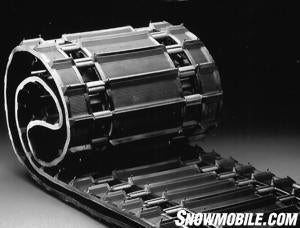 Basic tracks of the mid-1990s used minimal lug profiles.
Basic tracks of the mid-1990s used minimal lug profiles.
One other slight matter of concern was that if a Polaris buyer chose the new Indy Ultra and its XTRA-10 suspension, he would gain a lighter weight sled with a new 680cc triple while giving up on the plusher ride of the Polaris XTRA-12. Polaris didn’t see it that way as the company looked at the Indy Ultra as the being the sportier sled with the performance version of the XTRA suspension design. The XTRA-12 may have been softer and a better overall ride, but it gave away top end and some acceleration to the Ultra. That was the ultimate trade-off. Performance or plush!
The Indy Ultra was one of the first warriors in the battle for ride versus performance. Indeed, that battle hasn’t gone away as we see with the new Polaris Rush long travel suspension design. Nowadays you don’t lose as much performance as you did in the mid-1990s.
While a popular sled in its day, the Indy series is history, but you can still find Indy Ultra models for sale. We have seen some advertised for upwards of a US$1,100 with just over 6,000 miles on them. They are available, but you may have to look a bit. The good thing is that the 679cc Fuji triple had individual cylinders, so if you need some repairs, it shouldn’t be that hard to get a fix.
The 1996 Indy Ultra offered options like electric start, a mechanical reverse, a two-up seat and Polaris E-Z throttle, which relieved some of the pressure from pulling on three 38mm carbs.
If you are looking for a good all around classic ride, you might want to consider a 1996 or later Polaris Indy Ultra.
| 1996 Polaris Indy Ultra SP Specs | |
| Engine | Polaris/Fuji 679cc, liquid-cooled triple; tuned three-into-one exhaust; 3x38mm Mikuni carbs |
| Horsepower | 110-plus |
| Drive | Polaris drive & driven |
| Front Suspension | Polaris Indy parallel link trailing arm; 7.25 in travel |
| Rear Suspension | Polaris long travel XTRA-10 parallel rail slide suspension; 10.2-in travel |
| Length | 108.0 in |
| Width | NA |
| Height | 38.5 in |
| Ski Stance | 41.0 in |
| Track | 15.0 in. rubber |
| Weight | 515 |
| Brake | Hydraulic disc |
| Fuel Capacity | 10.7 US Gal |
| Features | Speedometer & tach; hand warmers; front bumper; carbide runners |
| Price | US$6,499 (in 1995) |
Related Reading
1990 Polaris Indy Sport GT Vintage Review
1991 Polaris Indy Lite Vintage Review
1991 Polaris Indy 650 RXL EFI Vintage Review



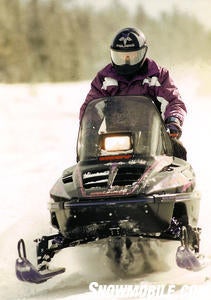
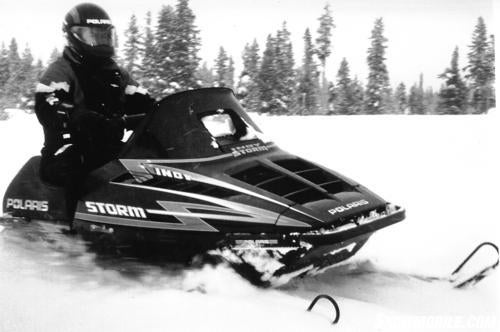
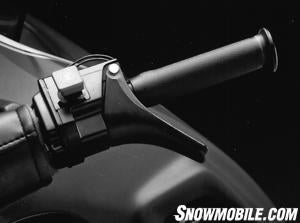
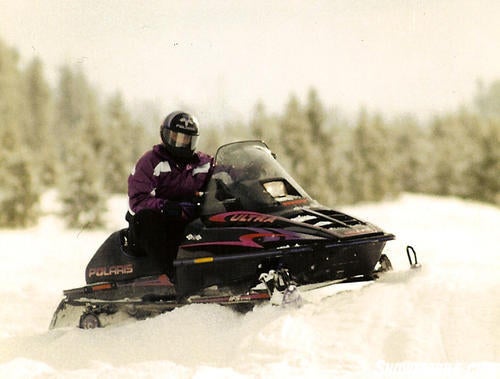





 Your Privacy Choices
Your Privacy Choices